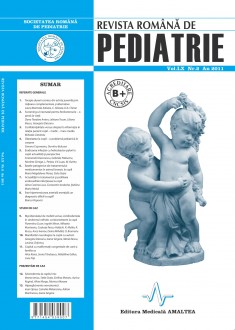SELECT ISSUE

Indexed

| |

|
|
|
| |
|
|
|

|
|
|
|
|
|
|
HIGHLIGHTS
National Awards “Science and Research”
NEW! RJP has announced the annually National Award for "Science and Research" for the best scientific articles published throughout the year in the official journal.
Read the Recommendations for the Conduct, Reporting, Editing, and Publication of Scholarly work in Medical Journals.
The published medical research literature is a global public good. Medical journal editors have a social responsibility to promote global health by publishing, whenever possible, research that furthers health worldwide.
Neurological manifestations in children with autism
Georgeta Diaconu, Ioana Grigore, Maria Iliescu and Lavinia Chiţimuş
ABSTRACT
The autism is a pervasive developmental disorder that can be associated with various neurological disorders. The aim of this study is to evaluate the incidence and characteristics of neurological abnormalities, the presence of epileptic seizures and/or EEG abnormalities in children with autism. Our study included 34 children (aged 2.5 to 13 years) diagnosed with autism. The study protocol included: general physical and neurological examination, IQ, tests of language, behavior, auditory attention, social skills and play, clinical features of epileptic seizures, EEG recordings. Neurological exam revealed mild hypotonia in 19 (55.88%) patients with autism, hyporeflexia in 21 (61.76%), the presence of stereotype movements in 24 (70.58%) and abnormalities of gait in 5 (14,80%) cases. Epileptic seizures were present in 9 children. EEG changes were present in all children diagnosed with autism and epilepsy, but also in those with no clinically critical episodes; they were represented by nonepileptic type in 29.41% cases and epileptic abnormalities in 44.12%. The changes of tone and reflexes, seizures and epileptic discharges were particularly common in children studied with autism. Our data suggests that EEG evaluation is important for these patients. The management of epilepsy in autism consists in the administration of antiepileptic drugs that, in addition to seizures control, also interfere with mood and behavioral disturbance observed in autism.
Key words: autism, child, epilepsy, EEG abnormalities, neurological abnormalities
